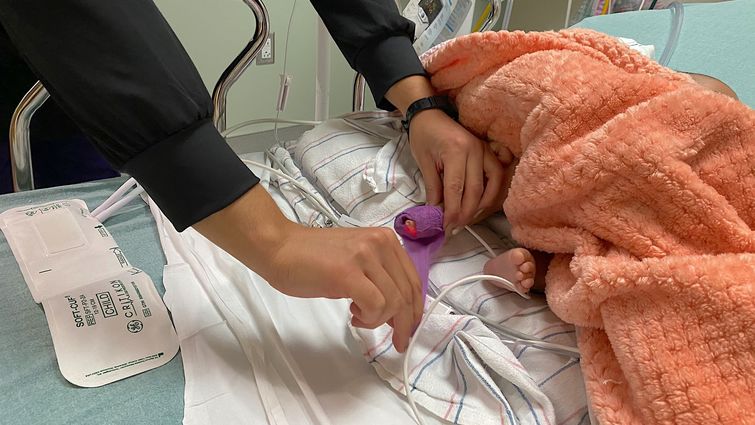
A nurse in the pediatric emergency department at LLU Children’s Hospital checks the blood pressure of a baby with RSV.
Hospitals throughout California are seeing an unprecedented number of pediatric patients with respiratory illnesses, especially RSV — or respiratory syncytial virus — putting them at or over capacity. RSV is an illness of the nose, throat, and lungs that typically causes sore throat, congestion, cough, and fever.
Merrick Lopez, MD, medical director of the pediatric intensive care unit at Loma Linda University Children’s Hospital, says RSV is essentially the common cold to an otherwise healthy child or adult. However, for those with under-developed immune systems or kids under 2, RSV can be much more severe and turn into bronchiolitis or pneumonia and cause hospitalization.
“RSV is nothing new, but the number of young children contracting the virus this early in the season is concerning,” Lopez says. “We usually see an increase in Emergency Department visits and hospital admissions in January or February. We have been surging since October, and we expect it to get worse.”
In addition to RSV, Children’s Hospital is also treating a high volume of patients with influenza, rhinovirus, and COVID-19, all of which are spread through fluid passed from a sick person’s mouth or nose.
RSV will often spread quickly in classrooms or daycares, and an older and healthier child may bring the virus back home to a younger child or infant. Lopez recommends that parents with young kids under the age of 2 or immunocompromised kids be on the lookout for RSV symptoms, which begin between two to five days after contracting the virus.
General symptoms include fever, congestion, cough, sneezing, runny nose, lack of appetite, and fussiness. If you see these symptoms, Lopez recommends monitoring your child, keeping them hydrated, and clearing their nose of mucus.
Lopez says babies and toddlers are more at risk because they aren’t able to clear their own mucus like an older child or adult can. Parents can clear their small child’s congestion at home by dropping a small amount of saline in their nose and suctioning it out with a bulb syringe. Feeding the baby or toddler immediately after will also help to clear their airway.
When to go to the hospital or urgent care
If your child is showing signs of labored breathing, such as faster breathing, flaring of nostrils, wheezing, and grunting during breathing, it may be time to go to seek medical care. Additionally, if your child is having issues eating and drinking or chooses not to eat or drink, there may be cause for concern. If the child is refusing or not tolerating drinking, then there is a risk of dehydration and that is good reason to seek urgent/emergent care. Lopez urges parents to call their child’s pediatrician for guidance.
“We want to reserve the Emergency Department for the most severe and urgent medical needs that can be life-threatening,” Lopez says. “We encourage parents to call their doctor or visit their local urgent care for illnesses or injuries that appear to be mild or non-life threatening.”
The best way to protect yourself and your kids is to continue using tried and true safety and hygiene measures — such as regular handwashing, avoid touching their faces, cough into arm or use a tissue, and frequently disinfect frequently touched surfaces or objects in the home and vehicle — and vaccination against flu and COVID. If possible, avoid close contact with sick people and stay home when you are sick.
Do you know where to go when your child needs care?
